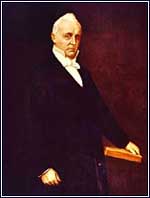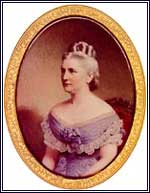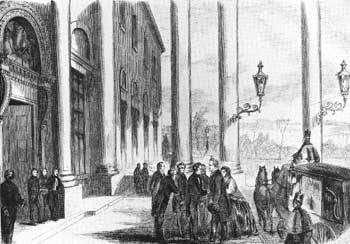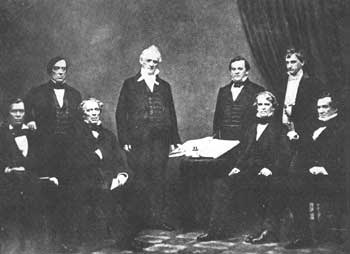






Biographical Sketches
|
JAMES BUCHANAN Fifteenth President • 1857-61 |
 James Buchanan | |
| ||
Buchanan, the first son and second child in a family of 10, was born in a log cabin just outside of Mercersburg, Pa., at Cove Gap (Stony Batter) in 1791. His father was a storekeeper and farmer who in time was to gain modest wealth. In 1796 the family moved into town. After attending a local elementary school and an academy, young Buchanan matriculated at Dickinson College, in Carlisle, Pa., as a junior and graduated in 1809. He then read law at Lancaster, where he was to maintain his home for the rest of his life. In 1812 he was admitted to the bar and began a highly successful legal career. Volunteering in a dragoon unit during the War of 1812 (1812-14), he saw brief service as an enlisted man in 1814, including participation in the defense of Baltimore.
Late that same year, as a Federalist, Buchanan entered the lower house of the Pennsylvania legislature (1814-16), after which he resumed his law practice. He next won a seat in the U.S. House of Representatives (1821-31). Following the demise of the Federalist Party, he switched to the Democrats and in 1828 supported Andrew Jackson for President.
 |
| Buchanan probably sat for this portrait in the 1830's or 1840's during his long congressional tour of duty. (Engraving by John Sartain, Library of Congress.) |
 Harriet Lane (hostess) |
Buchanan's reward was appointment as Minister to Russia (1832-33). He then began a long tour in the U.S. Senate (1834-45), including duty as chairman of the Foreign Relations Committee. During these years, he declined appointment as U.S. Attorney General and a seat on the Supreme Court. In 1844 he lost the Presidential nomination to James K. Polk, but then supported his candidacy. The latter designated him as Secretary of State (1845-49). He handled the difficult negotiations preceding and ending the Mexican War (1846-48), and settled the Oregon question with Britain in 1846.
Buchanan made two more unsuccessful bids for the Presidential nomination, in 1848 and 1852. He threw his weight behind the Compromise of 1850. He served as Minister to Great Britain (1853-56) under President Pierce. His close association with the proslavery Ostend Manifesto, concerning the acquisition of Cuba from Spain, brought him popularity in the South and scorn in the North. Nevertheless, his absence from the country during the turbulent controversy over the Kansas-Nebraska Act and his reputation as a compromiser made him a more acceptable candidate in 1856 than either Pierce or Stephen A. Douglas.
Mainly because of his solid showing in the South, Buchanan won a substantial plurality over Republican John C. Fremont; and ex-President Fillmore, the American ("Know Nothing") Party standard bearer, ran a distant third. The regional strength of the Republicans in the North, however, coupled with the virtual disappearance of the Whigs, showed clearly the breakdown in the old party system—to be further demonstrated by the split of the Democrats during Buchanan's administration into northern and southern wings.
Despite all his legislative, diplomatic, and legal experience, Buchanan, a Unionist, proved unable to soothe sectional passions. He brought to the Presidency a long-held conviction that slavery might be morally wrong but that the Federal Government lacked the right to interfere with it. He opposed regionally based parties, resented northern and abolitionist agitation on slavery, and felt the North and South should be tolerant of each other. Hoping to achieve compromise, he appointed a Cabinet representing all parts of the country.
 |
| President Pierce greets Buchanan as he arrives at the White House for his inauguration. (Engraving, in Frank Leslie's Illustrated Newspaper, 1857, Library of Congress.) |
Buchanan felt that a Supreme Court ruling on what he believed was an abstract question of the rights of slaveholders in the West would end the acrimony. Only 2 days after he took office, the Court handed down the Dred Scott decision, which he favored and may have earlier influenced. It gave slaveholders the right to take their human property wherever they chose, outlawed the Missouri Compromise, and implied that Congress lacked the power to make decisions concerning slavery in the Territories. In other words, they were all open to slavery and could exclude it only when they attained statehood. The Court's dictum obviously pleased the South and inflamed many elements of opinion in the North.
Turning to the still touchy issue of the status of Kansas Territory, in 1858 Buchanan, yielding to southern pressures, urged Congress to accept the proslavery Lecompton constitution and admit Kansas as a slave State—though the proslavery men in the Territory were heavily outnumbered. Buchanan hoped the admission of Kansas with or without slavery would remove the issue from public attention and calm Congress. But this proposal angered the Republicans and offended many of his own party; Congress rejected it. As a result, the South was enraged, and Kansas did not become a State until 1861. Until then, it remained a bloody symbol of the factionalism that was destroying the Nation.
By 1858 Buchanan's administration was near paralysis. The Republicans and anti-Lecompton Democrats scored heavily in the congressional elections and won a majority in the House; the Democratic Party divided into northern and southern elements. Southern votes in the Senate and Presidential vetoes doomed practically all House legislation. Government approached stalemate. Slow recovery from the Panic of 1857 produced gloom in the North. And in 1859 John Brown's antislavery raid on the Federal ordnance installation at Harpers Ferry, Va., reinflamed national emotions.
 |
| Buchanan and his Cabinet about 1859, Left to right: Secretary of the Interior Jacob Thompson, Secretary of State Lewis Cass, Secretary of War John B. Floyd, Buchanan, Secretary of the Treasury Howell Cobb, Secretary of the Navy Isaac Toucey, Postmaster General Joseph Holt, and Attorney General Jeremiah S. Black. (Library of Congress, Mathew B. Brady, ca. 1859.) |
The Presidential election of 1860 brought the crisis to a head. Buchanan's refusal to be considered for renomination helped to split his party. Four candidates—one each from the northern (Stephen A. Douglas) and southern (John C. Breckinridge) wings of the Democratic Party, John Bell from the Constitutional Union Party, and Lincoln from the Republican Party—entered the campaign. Lincoln was elected, though with far less than a popular majority. Rejecting the prospect of a Republican administration, the Southern States began to secede and seize Federal installations within their borders. Buchanan, who thought secession violated the Constitution but felt the Government could not legally prevent it, watched in anguish.
During Buchanan's remaining months in office, he at first made repeated but unfruitful efforts to compromise with the secessionists. He urged Congress to exercise its constitutional prerogatives and address the issue. He also backed proposals for a national convention and constitutional amendment.
Early in 1861, however, "lame-duck" Buchanan finally took stronger measures against the secessionists. Promising to uphold Federal authority, he sent reinforcements and supplies in the unarmed merchant ship Star of the West to the beleaguered garrison at Fort Sumter, in Charleston Harbor, S.C. When South Carolina batteries drove the ship away, he refused to evacuate the fort, though he made no further efforts to resupply it. The outbreak of war was thus averted, but only temporarily.
Another thorny problem for Buchanan besides slavery was the Mormon-dominated Territory of Utah. Congress had ignored its requests for statehood, and the Mormons opposed Federal officials, who were unsympathetic toward them. Buchanan replaced Brigham Young as Governor and dispatched a 2,500-man army to maintain law and order. The Mormons interpreted this as an invasion, and the short-lived and bloodless Mormon War (1857-58) broke out. Buchanan, sending a special representative, finally calmed the situation.
| HISTORIC SITES & BUILDINGS |
 "Corn Rigs," or Anderson House Wheatland |
Despite his preoccupation with the domestic slavery crisis, Buchanan also expended much effort on diplomacy. He clarified with Great Britain interpretation of the Clayton-Bulwer Treaty (1850), which called for nonintervention in Central America by either country. Although frowning on filibustering, he also expanded U.S. influence in Central and South America and discouraged intervention by European powers who were enticed by recurring political instability there. Like his predecessors Polk and Pierce, he continued southern-spawned efforts to purchase Cuba from Spain. In 1860 he received the first Japanese diplomatic mission to the United States.
After a public career that spanned the era from the War of 1812 to the Civil War—from the demise of the Federalists to the ascendancy of the Republicans—Buchanan lived out his remaining years of life at his Wheatland, Pa., estate. He retained his interest in politics and supported the Union during the Civil War, but its tragedy affected him deeply. He also did some writing and aided charitable causes. His death occurred in 1868 at the age of 77.
 |
 |
http://www.cr.nps.gov/history/online_books/presidents/bio15.htm
Last Updated: 22-Jan-2004